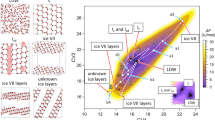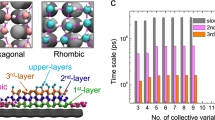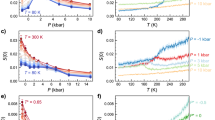Abstract
One of water’s unsolved puzzles is the question of what determines the lowest temperature to which it can be cooled before freezing to ice. The supercooled liquid has been probed experimentally to near the homogeneous nucleation temperature, TH ≈ 232 K, yet the mechanism of ice crystallization—including the size and structure of critical nuclei—has not yet been resolved. The heat capacity and compressibility of liquid water anomalously increase on moving into the supercooled region, according to power laws that would diverge (that is, approach infinity) at ∼225 K (refs 1, 2), so there may be a link between water’s thermodynamic anomalies and the crystallization rate of ice. But probing this link is challenging because fast crystallization prevents experimental studies of the liquid below TH. And although atomistic studies have captured water crystallization3, high computational costs have so far prevented an assessment of the rates and mechanism involved. Here we report coarse-grained molecular simulations with the mW water model4 in the supercooled regime around TH which reveal that a sharp increase in the fraction of four-coordinated molecules in supercooled liquid water explains its anomalous thermodynamics and also controls the rate and mechanisms of ice formation. The results of the simulations and classical nucleation theory using experimental data suggest that the crystallization rate of water reaches a maximum around 225 K, below which ice nuclei form faster than liquid water can equilibrate. This implies a lower limit of metastability of liquid water just below TH and well above its glass transition temperature, 136 K. By establishing a relationship between the structural transformation in liquid water and its anomalous thermodynamics and crystallization rate, our findings also provide mechanistic insight into the observed5 dependence of homogeneous ice nucleation rates on the thermodynamics of water.
This is a preview of subscription content, access via your institution
Access options
Subscribe to this journal
Receive 51 print issues and online access
$199.00 per year
only $3.90 per issue
Buy this article
- Purchase on Springer Link
- Instant access to full article PDF
Prices may be subject to local taxes which are calculated during checkout


Similar content being viewed by others
References
Speedy, R. J. & Angell, C. A. Isothermal compressibility of supercooled water and evidence for a thermodynamic singularity at −45°C. J. Chem. Phys. 65, 851–858 (1976)
Tombari, E., Ferrari, C. & Salvetti, G. Heat capacity anomaly in a large sample of supercooled water. Chem. Phys. Lett. 300, 749–751 (1999)
Matsumoto, M., Saito, S. & Ohmine, I. Molecular dynamics simulation of the ice nucleation and growth process leading to water freezing. Nature 416, 409–413 (2002)
Molinero, V. & Moore, E. B. Water modeled as an intermediate element between carbon and silicon. J. Phys. Chem. B 113, 4008–4016 (2009)
Koop, T., Luo, B. P., Tsias, A. & Peter, T. Water activity as the determinant for homogeneous ice nucleation in aqueous solutions. Nature 406, 611–614 (2000)
Finney, J. L., Hallbrucker, A., Kohl, I., Soper, A. K. & Bowron, D. T. Structures of high and low density amorphous ice by neutron diffraction. Phys. Rev. Lett. 88, 225503 (2002)
Moore, E. B. & Molinero, V. Growing correlation length in supercooled water. J. Chem. Phys. 130, 244505 (2009)
Mallamace, F. et al. The anomalous behavior of the density of water in the range 30K < T 373K. Proc. Natl Acad. Sci. USA 104, 18387–18391 (2007)
Johari, G. P., Fleissner, G., Hallburcker, A. & Mayer, E. Thermodynamic continuity between glassy and normal water. J. Phys. Chem. 98, 4719–4725 (1994)
Huang, C. et al. Increasing correlation length in bulk supercooled HO, DO, and NaCl solution determined from small angle x-ray scattering. J. Chem. Phys. 133, 134504 (2010)
Kohl, I., Mayer, E. & Hallbrucker, A. The glass water-cubic ice system: a comparative study by X-ray diffraction and differential scanning calorimetry. Phys. Chem. Chem. Phys. 2, 1579–1586 (2000)
Stevenson, J. D. & Wolynes, P. G. The ultimate fate of supercooled liquids. J. Phys. Chem. A 115, 3713–3719 (2011)
Moore, E. B., de la Llave, E., Welke, K., Scherlis, D. A. & Molinero, V. Freezing, melting and structure of ice in a hydrophilic nanopore. Phys. Chem. Chem. Phys. 12, 4124–4134 (2010)
Jähnert, S. et al. Melting and freezing of water in cylindrical silica nanopores. Phys. Chem. Chem. Phys. 10, 6039–6051 (2008)
Wedekind, J., Strey, R. & Reguera, D. New method to analyze simulations of activated processes. J. Chem. Phys. 126, 134103 (2007)
Liu, J., Nicholson, C. E. & Cooper, S. J. Direct measurement of critical nucleus size in confined volumes. Langmuir 23, 7286–7292 (2007)
Tanaka, H. Possible resolution of the Kauzmann paradox in supercooled liquids. Phys. Rev. E 68, 011505 (2003)
Xu, L. et al. Appearance of a fractional Stokes-Einstein relation in water and a structural interpretation of its onset. Nature Phys. 5, 565–569 (2009)
Kauzmann, W. The nature of the glassy state and the behavior of liquids at low temperatures. Chem. Rev. 43, 219–256 (1948)
Kiselev, S. Physical limit of stability in supercooled liquids. Int. J. Thermophys. 22, 1421–1433 (2001)
Angell, C. A. Insights into phases of liquid water from study of its unusual glass-forming properties. Science 319, 582–587 (2008)
Speedy, R. J. Stability-limit conjecture — an interpretation of the properties of water. J. Phys. Chem. 86, 982–991 (1982)
Poole, P. H., Sciortino, F., Essmann, U. & Stanley, H. E. Phase behaviour of metastable water. Nature 360, 324–328 (1992)
Sastry, S., Debenedetti, P. G. & Sciortino, F. Singularity-free interpretation of the thermodynamics of supercooled water. Phys. Rev. B 53, 6144–6154 (1996)
Mishima, O. & Stanley, H. E. The relationship between liquid, supercooled and glassy water. Nature 396, 329–335 (1998)
Mishima, O. Application of polyamorphism in water to spontaneous crystallization of emulsified LiCl–H2O solution. J. Chem. Phys. 123, 154506 (2005)
Moore, E. B. & Molinero, V. Ice crystallization in water's “no-man's land”. J. Chem. Phys. 132, 244504 (2010)
Liu, Y., Panagiotopoulos, A. Z. & Debenedetti, P. G. Low-temperature fluid-phase behavior of ST2 water. J. Chem. Phys. 131, 104508 (2009)
Limmer, D. T. & Chandler, D. The putative liquid-liquid transition is a liquid-solid transition in atomistic models of water. J. Chem. Phys. 135, 134503 (2011)
Plimpton, S. J. Fast parallel algorithms for short-range molecular dynamics. J. Comput. Phys. 117, 1–19 (1995)
de La Llave, E., Molinero, V. & Scherlis, D. A. Water filling of hydrophilic nanopores. J. Chem. Phys. 133, 034513 (2010)
Jacobson, L. C., Hujo, W. & Molinero, V. Thermodynamic stability and growth of guest-free clathrate hydrates: a low-density crystal phase of water. J. Phys. Chem. B 113, 10298–10307 (2009)
Acknowledgements
This work was supported by the Arnold and Mabel Beckman Foundation through a Young Investigator Award to V.M. We thank P. G. Debenedetti for discussions and D. P. Fernandez for criticism of the manuscript.
Author information
Authors and Affiliations
Contributions
V.M. conceived and designed the study and wrote the paper. E.B.M. and V.M. performed the simulations, analysed the data and interpreted the results.
Corresponding author
Ethics declarations
Competing interests
The authors declare no competing financial interests.
Supplementary information
Supplementary Information
The file contains a Supplementary Discussion and Supplementary Figures 1-7 with legends. (PDF 4587 kb)
PowerPoint slides
Rights and permissions
About this article
Cite this article
Moore, E., Molinero, V. Structural transformation in supercooled water controls the crystallization rate of ice. Nature 479, 506–508 (2011). https://doi.org/10.1038/nature10586
Received:
Accepted:
Published:
Issue Date:
DOI: https://doi.org/10.1038/nature10586
This article is cited by
-
Coupling of Adhesion and Anti-Freezing Properties in Hydrogel Electrolytes for Low-Temperature Aqueous-Based Hybrid Capacitors
Nano-Micro Letters (2024)
-
Fluxional Hydrogen Bonds in Small Water Clusters (H2O)n (n = 2–6)
Journal of Cluster Science (2024)
-
Microscopic ordering of supercooled water on the ice basal face
Communications Materials (2023)
-
Regulating interfacial reaction through electrolyte chemistry enables gradient interphase for low-temperature zinc metal batteries
Nature Communications (2023)
-
Electron diffraction of deeply supercooled water in no man’s land
Nature Communications (2023)
Comments
By submitting a comment you agree to abide by our Terms and Community Guidelines. If you find something abusive or that does not comply with our terms or guidelines please flag it as inappropriate.



